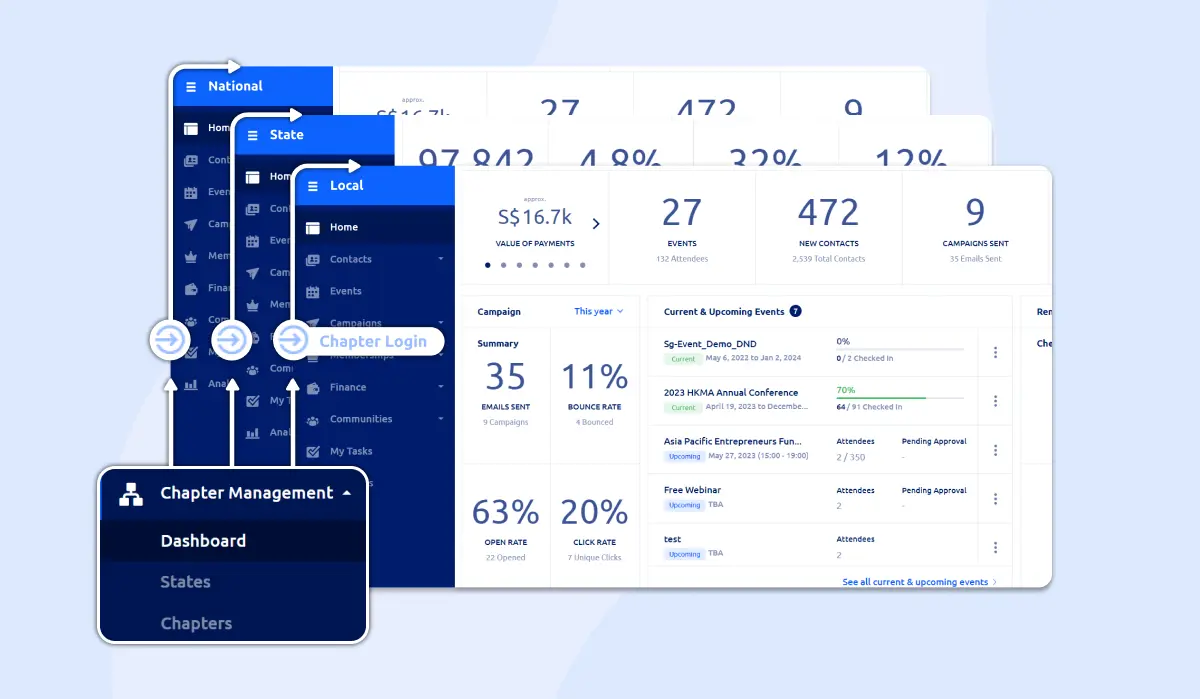
The chapter models may differ among organizations, as associations adopt models that best align with their members' interests and requirements. Despite these differences, the models generally share similarities because they serve an organization's fundamental purpose.
However, understanding the unique characteristics and advantages of each model can help you select the most suitable one for your association.
Read this blog to explore various association chapter models, their benefits, and how they can maximize their impact.
Key Takeaways
- Association chapter models vary but serve the basic purpose of the association, tailored to meet members' interests and needs.
- Traditional chapter models may become ineffective over time due to changing technology and member expectations.
- Evaluating your current chapter model involves assessing member satisfaction, financial health, and flexibility for change.
- Successful chapter models align with the association's mission, offer valuable services, maintain uniqueness, and ensure smooth collaboration.
- Glue Up Chapter Management Software provides a comprehensive solution for enhancing chapter operations, including unifying chapters into one community, streamlining membership workflows, aggregating data, ensuring brand consistency, and facilitating digital transformation.
Why Rethink Your Chapter Model?
Before exploring different chapter models, it's important to understand why you should reconsider your current approach. Associations rely on chapters to engage with members locally. However, as times change and technology evolves, your adopted traditional chapter models may no longer be as effective.
These existing models can provide an inconsistent experience to members, as their needs vary from chapter to chapter. Providing a non-personalized experience would result in inconsistency and would not serve their needs.
If you face the same and think your chapter models are outdated, it's time to rethink and consider various models that will meet your needs and serve the association in the long term.
What Are the Different Types of Association Chapter Models

The most common chapter model remains a state structure at 81%. This state structure includes the following models:
Autonomous Chapter Model
In the autonomous chapter model, local chapters have the authority to operate independently of the national association, tailoring their activities to the specific needs of their region.
While chapters can arrange activities, provide opportunities, and address member needs not covered at the national level, they must still adhere to the association's rules and regulations.
Additionally, members can choose between participating in national association activities or those organized by local chapters.
Advantages of the Autonomous Chapter Model
The autonomous chapter model has some notable advantages, such as:
- More Choice for Members: The autonomous chapter model offers more choices for members, allowing them to select between national and local activities.
- Local Control: It provides local control, enabling chapters to tailor programs to suit regional needs.
- Less Standardization: Additionally, it offers less standardization, allowing for more flexibility in meeting member needs.
Disadvantages of the Autonomous Chapter Model
The autonomous chapter model also has some disadvantages, including:
- Less Cohesion: Chapters may operate independently, leading to a lack of unified direction or alignment in goals and activities.
- Uneven Resources: Some chapters may have more resources or funding than others, creating disparities in the quality or quantity of services provided.
- Duplication of Effort: Chapters might unknowingly replicate the efforts of other chapters, resulting in wasted resources and inefficiencies.
Integrated Chapter Model
The integrated chapter model provides automatic membership in the local chapter when joining the national association, as both entities are closely integrated.
Under this model, the chapter is bound by the association at every level and has limited autonomy in decision-making. Members must pay for activities at the national association and the chapter separately.
Advantages of Integrated Chapter Model
The following are the advantages of the integrated chapter model:
- One-Stop Shop: Members have a single point of contact for all association-related matters, simplifying member communication and engagement.
- Streamlined Administration: The integrated model reduces administrative burden by centralizing processes and procedures, making them more efficient and consistent.
- Standardized Approach: Since chapters operate under the same rules and guidelines as the national association, governance in multi-chapter organizations is uniform.
Disadvantages of the Integrated Chapter Model
The integrated chapter model also has some disadvantages, which are as follows:
- Limited Flexibility: Chapters have less autonomy to adapt to local needs or innovate independently.
- Less Local Focus: Due to the centralized nature of the model, the focus may shift away from local community issues and concerns.
- Potential Disconnection: Members may feel disconnected from the local chapter or perceive a lack of local representation due to the overarching influence of the national association.
Flexible Chapter Models
Associations are moving away from old and traditional chapter models because they want their members to find value in their association. Sticking to these traditional models won't offer much value for your members.
Hence, associations are seeking other options, probably a mix of both. Mariner Management CEO Peter Houstle encourages associations to consider a hybrid approach.
He states, "Chapters used to make a living off in-person events only, but now that's harder to do because there are so many more competing entities and channels out there. Chapters can still be a critical delivery channel for education and networking, but I think they have to fundamentally adapt—for instance, use virtual webinars as a gathering tool for members between face-to-face meetings."
According to stats, 69% of associations said they're using a mix of options. Moreover, a flexible chapter model has become the need of the hour for associations, as it provides a set of advantages, as follows:
- Flexible Membership: Allows members to choose their level of involvement and engagement, catering to diverse needs.
- Informal Groups: Improves networking and spontaneous collaboration among members outside formal settings.
- Chapter-Driven Programming: Empowers chapters to create tailored programs and events based on local needs and interests.
- Digital Collaboration Tools: Facilitates seamless communication and collaboration among members and chapters, regardless of geographical barriers.
What Role Do Chapters Play Today?

Chapters are very important for thriving associations. Local chapters provide nationwide recognition, serving as functional hubs representing the association in various parts and cities.
Overall, chapters play a pivotal role, with notable functions including:
Workforce Training and Support:
Local chapters play a handy role in providing workforce training and support to the association. Training every member and providing assistance would be challenging for the association's nationwide spread.
However, local chapters in different cities make this task manageable, as each chapter trains a portion of members, simplifying the process for the association.
Advocacy and Regulation:
Ensuring compliance and navigating regulatory frameworks across different regions can be daunting for the association on a nationwide scale. However, with local chapters in various cities, the burden is distributed, allowing each chapter to focus on specific regulatory challenges in their area.
Therefore this decentralized approach simplifies advocacy efforts and enhances the association's ability to navigate diverse regulatory landscapes effectively.
Leadership Pipeline:
Identifying and nurturing leadership talent across a nationwide association can be challenging. However, with local chapters in different cities, the association can cultivate leadership at the grassroots level.
Each chapter can focus on developing leaders within its region, creating a robust pipeline of talent that can contribute to the association's leadership at all levels.
This approach not only strengthens the leadership base but also ensures a steady flow of capable leaders for the association's future.
Information Flow:
Local chapters are instrumental in facilitating the flow of information within the association. Maintaining effective communication and information dissemination across a nationwide association can be complex. However, with local chapters in different cities, the association can ensure that information reaches members in a timely and efficient manner.
Each chapter serves as a medium for information, sharing updates, resources, and best practices with members in their region. This approach enhances information flow, ensuring that members are well-informed and engaged, ultimately strengthening the association as a whole.
How Can Chapters Continue to Support Your Mission and Strategies?
You can utilize chapters to support your mission and strategies in several ways.
- Arrange Targeted Programs: Chapters help you arrange programs such as workshops, seminars, and conferences that are specifically designed to promote and advance your association's mission.
- Direct Members Alignment: Chapters play an important role in ensuring that members understand and align with the association's mission and strategies. You can communicate the mission's importance to members, encouraging them to participate actively in initiatives that further the association's goals.
- Organize Marketing Drives: Chapters can organize targeted and better marketing campaigns that promote your association's mission and vision. These campaigns can include social media campaigns, email newsletters, and promotional events that raise awareness about your association's work and attract new members who resonate with its mission.
- Target New Members: Chapters are instrumental in attracting new members who share the same mission as the association. Moreover, engagement with the local community and networking with like-minded individuals and chapters can expand your association's reach and attract individuals who are passionate about its mission.
- Retain Aligned Members: Chapters can also offer effective member retention of members who are aligned with your association's mission by providing them with opportunities for engagement and involvement. These meaningful and rewarding experiences can ensure that members remain committed to your association's mission over the long term.
How Can You Evaluate and Implement Changes to Your Current Model?

Evaluating your current chapter model is not a simple task; however, it can be achieved by following these ways:
Assessing Your Current Model
First, you need to assess your current model by monitoring its performance. Learn whether your members are satisfied with this model and, if so, to what extent.
Then, assess your financial health to determine if this model helps you achieve financial independence. Next, evaluate whether this model helps you achieve your goals or presents any hindrances.
Finally, assess how flexible this model is in adopting new initiatives or technology. You can do this through polls, surveys, or questionnaires.
Crafting a Roadmap for Change
If you have identified any gaps while assessing your current model or found room for improvement, draft a roadmap. Highlight the changes you want in the current model or if the entire model will be replaced, then outline the timeline.
Define your geographical preferences for each chapter, and specify your future outcomes and expectations from your desired model.
Also, mention the task force, human resources, or other resources or funds that will be required to achieve this feat and make this model implemented and functional.
What Does Chapter Model Success Look Like?
The benchmarks of chapter model success are as follows:
- Alignment with the Association's Mission and Brand: Chapters and national associations should be on the same page, reflecting the association's mission, aims, and brand.
- Valuable Offerings: The national association and chapters must offer valuable offerings that resonate with members.
- Uniqueness and Tailored Services: Chapters maintain their uniqueness and offer tailor-made services to meet the specific needs of their region.
- Defined Roles and Responsibilities: Chapters and the national association have defined roles and responsibilities, ensuring effective collaboration.
- Collaboration: There is a smooth collaboration between chapters and the national association, fostering a cohesive environment.
- Support and Resources: The national association thoroughly supports chapters, providing them with all the necessary resources and funds for smooth operation.
Maximize Chapter Model Success with Glue Up Chapter Management Software

Regardless of your chapter model, investing in chapter management software is essential. Choosing software like Glue Up, which offers a comprehensive set of tools for chapter management, can greatly benefit your association. Glue Up provides numerous features designed to streamline chapter management.
Let's explore some of these features.
Unify Multiple Chapters into One Community
- Foster engagement through 1-on-1 chats, posting and sharing features, and customizable user Profiles.
- Enhance member experience by providing a private community space with access to chapter information, events, and announcements.
Universal Membership Workflow
- Seamlessly manage memberships at the chapter level, while aggregating member lists to the national level.
- Ensure consistency with a streamlined membership process, offering custom application forms and a painless renewal process.
Data Aggregation
- Gain comprehensive insights with a unified dashboard, financial reports, and consolidated chapter data.
Brand Consistency
- Maintain a consistent brand image across chapters with effective chapter community management and a custom-branded website.
- Enhance communications with members through consistent messaging and easy-to-use customizable templates.
Digitally Transform Your Chapter Organization
- Make informed decisions with in-depth analytics.
- Increase efficiency with task management and workflow automation.
Explore how Glue Up Chapter Management Software can enhance your association's chapter operations. Request a demo to learn more.



